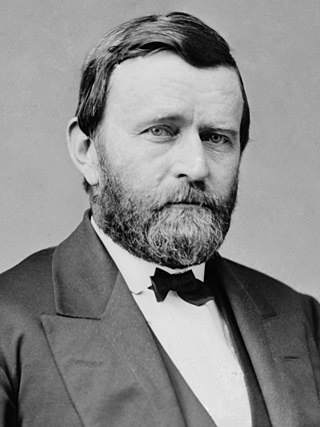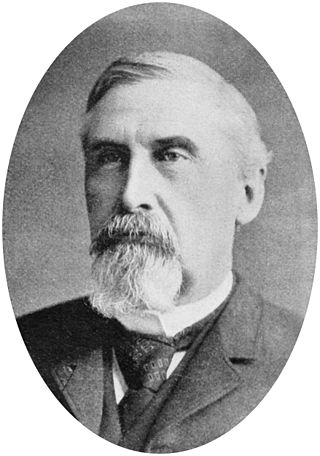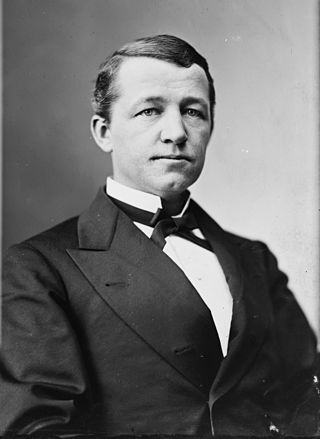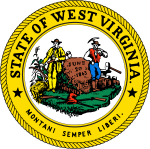
Presidential elections were held in the United States on November 3, 1868. In the first election of the Reconstruction Era, Republican nominee Ulysses S. Grant defeated Horatio Seymour of the Democratic Party. It was the first presidential election to take place after the conclusion of the American Civil War and the abolition of slavery. It was the first election in which African Americans could vote in the reconstructed Southern states, in accordance with the First Reconstruction Act.

Francis Harrison Pierpont, called the "Father of West Virginia," was an American lawyer and politician who achieved prominence during the American Civil War. During the conflict's first two years, Pierpont served as Governor of the Restored Government of Virginia and, in this capacity, administered the part of Virginia then under Unionist control before West Virginia's admission to the Union as a separate state. After recognizing the creation of West Virginia, Pierpont continued to serve as Governor of the Restored Government. However, the degree of civil authority he could exercise was minimal for the remainder of the war. Having claimed to be the legitimate Governor of Virginia for the duration of the conflict, Pierpont assumed civil control of the state's entire post-1863 territory following the dissolution of the Confederacy and continued to serve as Governor during the early years of Reconstruction.

William Erskine Stevenson was an American cabinet-maker, farmer, and Republican politician from Parkersburg, West Virginia. He was the third governor of West Virginia from 1869 until 1871.

John Jeremiah Jacob was a Democratic politician from Green Spring in, in the U.S. state of West Virginia. Jacob served two terms as the fourth governor of West Virginia from 1871 to 1877. He was also elected to the West Virginia House of Delegates from Hampshire County in 1868 and from Ohio County in 1879.
The 1868 Democratic National Convention was held at the Tammany Hall headquarters building in New York City between July 4, and July 9, 1868. The first Democratic convention after the conclusion of the American Civil War, the convention was notable for the return of Democratic Party politicians from the Southern United States.

Henry Horatio Wells, a Michigan lawyer and Union Army officer in the American Civil War, succeeded Francis Harrison Pierpont as the appointed provisional governor of Virginia from 1868 to 1869 during Reconstruction. A Radical Republican labeled a carpetbagger, Wells was defeated for election in 1869 by Gilbert C. Walker, who also became his appointed successor. Wells then served as U.S. Attorney for Virginia and later for the District of Columbia.

The Virginia Conventions were assemblies of delegates elected for the purpose of establishing constitutions of fundamental law for the Commonwealth of Virginia superior to General Assembly legislation. Their constitutions and subsequent amendments span four centuries across the territory of modern-day Virginia, West Virginia and Kentucky.

James Madison Harvey was a United States senator from Kansas and the fifth governor of Kansas.

Nathan Goff Jr. was a United States representative from West Virginia, a Union Army officer, the 28th United States Secretary of the Navy during the administration of President Rutherford B. Hayes, a United States circuit judge of the United States Court of Appeals for the Fourth Circuit and of the United States Circuit Courts for the Fourth Circuit and a United States senator from West Virginia.
Events from the year 1868 in the United States.

The 1868–69 United States Senate elections were held on various dates in various states. As these U.S. Senate elections were prior to the ratification of the Seventeenth Amendment in 1913, senators were chosen by state legislatures. Senators were elected over a wide range of time throughout 1868 and 1869, and a seat may have been filled months late or remained vacant due to legislative deadlock. In these elections, terms were up for the senators in Class 1.

The 1856 United States presidential election in Virginia took place on November 4, 1856, as part of the 1856 United States presidential election. Voters chose 15 representatives, or electors to the Electoral College, who voted for president and vice president.

The 1868 United States presidential election in West Virginia took place on November 3, 1868, as part of the 1868 United States presidential election. West Virginia voters chose five representatives, or electors, to the Electoral College, who voted for president and vice president.

The 1936 United States presidential election in West Virginia took place on November 3, 1936, as part of the 1936 United States presidential election. West Virginia voters chose eight representatives, or electors, to the Electoral College, who voted for president and vice president.

The 1932 United States presidential election in West Virginia took place on November 8, 1932, as part of the 1932 United States presidential election. West Virginia voters chose eight representatives, or electors, to the Electoral College, who voted for president and vice president.

The 1920 United States presidential election in West Virginia took place on November 2, 1920, as part of the 1920 United States presidential election which was held throughout all contemporary 48 states. Voters chose eight representatives, or electors to the Electoral College, who voted for president and vice president.

The 1928 United States presidential election in West Virginia took place on November 6, 1928, as part of the 1928 United States presidential election which was held throughout all contemporary 48 states. Voters chose eight representatives, or electors to the Electoral College, who voted for president and vice president.

The U.S. state of West Virginia reported its first confirmed case relating to the COVID-19 pandemic on March 17, 2020, becoming the last state to do so. The patient had shown symptoms for several days prior. On March 29, 2020, the state reported its first COVID-19 death.

The 1867 Maryland gubernatorial election took place on November 5, 1867. Incumbent Governor Thomas Swann did not run for re-election.




















